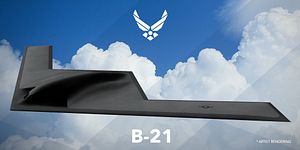This week, the B-21 Long Range Strike Bomber got a name: The Raider. The Air Force (with input from its airmen) selected well; Raider evokes themes consistent with the history of airpower theory, while not promising to replicate any particular legacy aircraft (the A-1 “Skyraider”) comes closest.
Now that the B-21 has its name, a less remarked upon item has emerged from the discussion over the future of the bomber. Listed in the “family of systems” associated with the B-21 is a long-range penetrating fighter (we’ll provisionally call it the “Little Buddy”) that would accompany the B-21 on deep strikes, especially against targets in distant, heavily defended areas such as western China. Although the need for such a fighter was mentioned in the initial public discussions of the LRSB, it has thus far attracted little attention from analysts.
The debate over the relationship between fighters and bombers has a long, complex history. In the early days of military aviation, bomber advocates argued that self-defending bombers could strike their targets (and deliver decisive military effect) without the support of smaller, shorter-ranged fighters. In World War II, the United States and the U.K. tried to put this theory to work over Germany, only to find that heavily armed bombers could still easily fall victim to German interceptors. By the end of the war, P-51 Mustangs and other fighters accompanied bombers on raids over Germany, fending off the interceptors to allow the bombers to hit their targets.
Debate in the Cold War bounced back and forth on whether bombers needed fighter support. The architects of the B-36 Peacemaker came up with a scheme to launch an aerial-based fighter from the bomber itself. Later bombers expected to defend themselves, if not through guns then through electronic warfare, high speeds, low-level maneuverability, and stand-off weapons. Stealth represents the epitome of this approach, with lone bombers evading air defense networks to deliver their lethal payloads. Indeed, the Air Force once boasted about the cost-effectiveness of the B-2, which could conduct strikes without the large support system that other bombers required.
The expressed interest in a long-range, penetrating fighter (one which would necessarily differ significantly in conception from the F-22 or the F-35) is thus quite interesting from the point of view of airpower history. It’s also pretty interesting from a procurement standpoint; the Air Force hasn’t talked much about the necessity for such a fighter, perhaps because it would dampen enthusiasm for the supposedly inexpensive (only $511 million a pop) LRSB.
But there’s one more point worth thinking about. The B-21 Raider needs its Little Buddy if it wants to attack missile installations in western China. These installations will presumably house anti-ship ballistic missiles, and so this mission is in keeping with the larger project of defeating China’s A2/AD system. These installations also, however, house China’s nuclear deterrent. In effect, the United States has committed to developing systems that are capable of neutralizing China’s second-strike nuclear deterrent capability. In effect, the Air Force is saying that the United States has no plans to fall into a classic, Cold War deterrent relationship with China. The U.S. has enjoyed presumptive nuclear dominance over the PRC since the latter’s inception, and the U.S. will continue to pursue that dominance. That decision, generally unremarked upon, is probably an even bigger deal than the long-range penetrating fighter.

































